|

This is the main reason that, even today, sesame laddu's (sweets) are prepared in villages on the auspicious day of Makara Sankranti (Winter Solstice, celebrated as a Hindu festival). On one hand this gives mental peace and on the other hand it grants a long and healthy life.
Kinds of Sesame
Apart from its religious significance, sesame is used as a medicine. In Ayurveda, it is considered to be an extremely beneficial and strong medicine. It is a rainy season crop, and is mainly of three kinds: 1. black sesame 2. white sesame 3. red sesame.
Black sesame contains the best qualities with respect to nutrition. White sesame possesses medium qualities and red sesame has no qualities at all.
The most important specialty of sesame is that is contains four rasas (flavors), hot, bitter, sweet and pungent.
Qualities of Sesame
Sesame is bitter in preparation, heavy for digestion, tasty, oily, hot, destroyer of phlegm - bile, provides strength and is beneficial for hair. Its lep (pack) is cold. It cures many diseases, dental and wind related problems, increases milk, fire and intelligence and decreases excess urination.
Sesame in the Form of Sweets
Sesame is hot in nature and is therefore used for preparing sweets in winter season. Different types of sweets like gajak, laddu, revadi, etc. are made of sesame during the winter and protect us from cold. The chances of catching cold reduce if we eat these sweets. Sesame laddu's are beneficial for those children who normally have the problem of bed-wetting in winters. Children having this problem should be given one sesame laddu each in the morning and evening. The bed wetting problem and the urge to urinate at small intervals also gets cured.
Sesame is not just an eatable item, in Ayurveda it is considered to be a great medicine. Regular consumption of sesame protects from many diseases and general physical weakness. The patient develops a good and effective resistance power when compared to normal persons. In other words, the patients develop the capacity to fight against disease.
Medicinal Use of Sesame
Dental problem: Sesame is extremely beneficial in case of loose teeth or the person is suffering from pyorrhoea and toothache. In such case, let the sesame oil remain in the mouth for 10 - 15 minutes and do gargles. This relieves toothache. Another instant remedy to cure toothache is to do gargles with hot sesame oil mixed with asa fetida and black cumin seeds.
Bleeding Dysentery:
Sesame is very beneficial for bleeding dysentery. Grind 20 gm of sesame and add 30 ml of goat's milk, this medicine gives relief in case of bleeding dysentery. Grind few sesame seeds and mix it with jaggery powder, let the child suffering with this problem lick it with honey, the child will get immediate relief. Grinded sesame mixed with butter also cures this problem.
Burns:
If any part of the body has burnt and the person suffers from extreme pain and burning sensation, then apply the lep (pack) of sesame, camphor and ghee on the affected area. This reduces the pain and burning sensation. Grind sesame with milk and apply the lep (pack) on the affected part, this will slowly reduce the burning sensation and the pain.
Impotency:
Consumption of sesame gives lot of strength and therefore it removes impotency. Boil 15 gm of sesame in 10 gm of Gokharu (briar) milk, this medicine taken regularly stops the secretion of vital humors of the body, reduces impotency and weakness. Regular consumption of this medicine for one month definitely cures the impotency.
Menstrual Cycle:
Consumption of Sesame can be very beneficial in case of severe pain during menstrual cycle or mild menstruation. Cook one tola (around 12 gm) sesame in 20 tolas (240 gm) of water and let it reduce to one-fourth of the quantity, remove it from flame and let it cool. Add jaggery in this syrup and consume it regularly every morning, this will cure the problem of mild or irregular menstruation. Add shakkar (jaggery powder) in sesame and barley powder and give this to a women who has delivered a baby, her bleeding will stop.
beautifully sung on 10 Audio CDs

Regular Price: $49.45
(with free postage to anywhere in the world)
| |
| | said this on 19 Nov 2009 2:31:13 AM EST Oh yes, sesame seeds. I can never get enough of them. I eat sesame papadams (papad, pampad) twice a day. (3-4 each time) It feels like an addiction. Maybe there's some nutritional value in them that my body needs. I don't fry them. I use a flat double-iron utensil that has lots of small holes and put it over the gas flame. Cooks very nicely, flat, brown and crisp. I would love to eat more sesame sweets too, but I keep sugar to a minimum. Highly recommended. Nice article. |
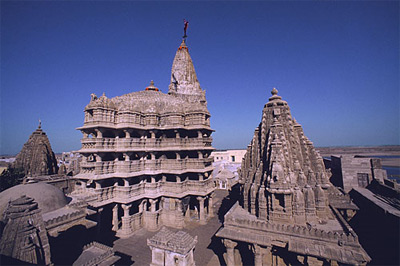
Activities include the running of Shri Dwarkadheesh Sanskrit Academy and Indological Research Institute, Shri Shardapith Arts-Commerce and college of Education, Shri Shankaracharya Abhinav Sachchidanad Tirtha Sanskrita Mahavidyalaya and ved Vidyalaya at Dwarka and Gaushala in Barvala near Bhavnagar district. The devotees coming to Dwarkadheesh temple are also benefited with free meals provided by Shardapith as prasad.
Chandaramaulishwar Shivalinga in Shardapith:
A devotee who comes to Shardapith also has a chance to see Chandramaulishwar Shivalinga which is daily worshipped by present Shankaracharya. It is said that Lord Shiva had gifted four forms of shivalinga (known as Chandramaulishwar) to Adi Shankaracharya. Over the years they were established in four piths and are worshipped by Shankaracharya. The Shivalinga is made from sapphire. Near the Shardapith is the temple of Bhadrakali Mataji, which is aradhyadevi of Shankaracharya.
Dwarkadheesh temple premises:
Sri Krishna's Dwarkadheesh temple premises are considerably huge and house more than 24 temples apart from the main Dwarkadheesh temple. The various temples in the premises are: Shri Radha Krishna, Shri Purushottam, Shri Radhika, Shri Baldev, Shri Satyabhama, Shri Laxmi Narayan, Shri Trivikram, Shri Shakti Mataji, Shri Kusheshwar Mahadev, Shri Kashi Vishwanath, Shri Kolva Bhagat, Shri Datatreya, Shri Aniruddha, Shri Pradyuman, Shri Ambaji, Shri Devki Mataji, Shri Madhavray, Sage Durvasa, Shri Jambuvati, Shri Gyanmandir Nardapith, etc.
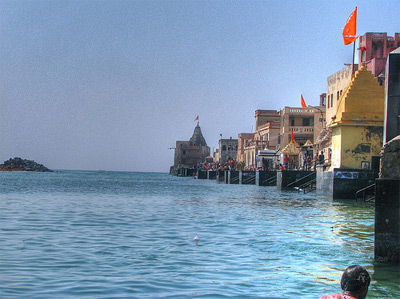
Gomti Ghat:
Places around Dwarka:
Dwarka is a beautiful place to visit with several attractions around it. However, four holy shrines are particularly popular. They are Nageshwar Jyotirlinga temple, Gopi Talav, Bet Dwarka and Rukmini temple.
Gopi Talav:
Talav means Pond. It is 21 km from Dwarka and 5 km from Nageshwar Jyotirlinga temple. Lord Krishna killed the demon Bhaumasura here, freeing 16,000 princesses from His palace. These gopi princesses fell in love with Lord Krishna and wanted to marry him, thus the name Gopi Talav.
Another story is related with Arjuna. After the battle at Kurukshetra, Arjuna thought himself to be the best warrior of the world. To show him his place, Lord Krishna asked him to escort his queens to Bet Dwarka. On the way, just near this pond, Arjuna was attacked by people of Kaba community, and Arjuna was defeated. The queens were shocked at this and died in this pond. So it is called Gopi Talav. The famous phrase ‘Kabe Arjun luntiyo,vohi dhanush vohi ban’ reflects this incident.
Gopi Talav is a small pond and the sandal like yellow sand is known as Gopi Chandan. The devotees take Gopi Chandan, believing it to be very good for skin diseases.
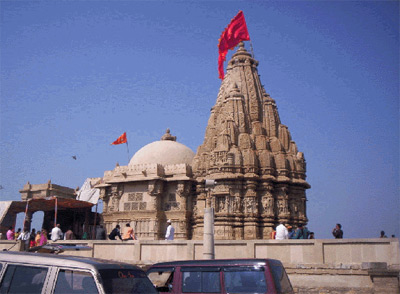
Rukmini Temple:
However, on the way, Rukmini felt thirsty. Lord Krishna got water for her. She was so thirsty that she gulped all the water without offering it to anyone. This enraged the sage Durvasa who is known for his bad temper, and the sage cursed her. He said that for 12 years she will remain separate from Lord Krishna, and so the temple is three kilometers away from the main temple of Lord Krishna. Visitors can also see the ancient chori mandap in the temple.
Bet Dwarka:
Bet means island. One can reach here from Okha, 30 kms from Dwarka. From Okha, the ferry boats bring tourists to Bet Dwarka. It takes around 20 minutes to reach the place, which is known for its variety of Shanks (conches). For Vaishnavs, shankhs bought from here have special significance. For this reason, the place also called Shankhoddhar, the place of Dhwani (sound) shakti.
The Bet is spread around a 12 km area from West South to East. The site also has archeological importance. A team of archeologists have carried out onshore and inter-tidal zone explorations and a few trial trenches were laid to trace a proper cultural sequence. The findings of Bet Dwarka may be divided into two broad periods: Proto-historic period, which includes a small seal of conch shell engraved with a three-headed animal motif, two inscriptions, a copper fishhook and late Harappan pottery (circa 1700-1400 BC); and the Historical period, consisting of coins and pottery. Onshore and inter-tidal zone explorations have indicated some kind of shoreline shifting around the Bet Dwarka Island as a few sites get submerged during high tide.
Bet Dwarka Main Temple:
Lord Dwarkadheesh is the presiding Deity in the main Bet Shankhoddhar Temple in Bet Dwarka. Vaisanavas call the presiding Deity Lord Shankho-narayan. Evidence showS that the idol of Dwarkadheesh was carried out from Dwarka and the new temple was established in Bet Dwarka in vikram samvat 1616-17. After some years, new temples of Shri Laxmiji, Satyabhama and Jambavati were also built here. During monsoon season, Lord Dwarkadheesh yatra is taken out in Bet Dwarka on every ekadashi.
The daily puja
a ritual worship ceremony'); return false">puja of Laxmiji and Satyabhamaji, the two main queens (pattaranis) of Lord Krishna is taken care of by a brahmachari priest who also wears woman like jewellery on his body.
Like many other Hindu temples, this temple was also looted, in this case by the British. In the first attempt in 1851, people of the Vagher community defeated the attempt, but the second time the British succeeded. They damaged the structures of the temple and looted the jewelry worth Rs.14 crore. The devotees, however, managed to shift the idols of Dwarkadheesh and the goddesses to a nearby place. The present temple was constructed in 1860, and artisans of the area offered their labour free to build the temple.
Temple Timings: The main temple at Bet Dwarka opens at 6 in the morning and closes at 9 in the night. Total of 13 bhogs are offered and 9 artis are performed during the day. There are 16 temples in all. Even today, the bhog is prepared using wood as fuel, maintaining all traditional style. The 21.5 meter cloth is used for Dhwajarohan in the main temple and it costs around Rs. 3500.
Hanuman Dandi Temple
Nearby is the Hanuman Dandi Temple, where Hanuman and his son Makardhwaj had met. People have great faith in the temple and many come here for the fulfillment of their desires. The temple priest gives a sopari (beetle nut) to the devotee, and when his wish is fulfilled, the devotee comes here with the same sopari given by the priest, now with golden platting on it, and offers it to Hanumanji. Hanuman Dandi temple is 5 km away from the main temple, and local vehicles are available.



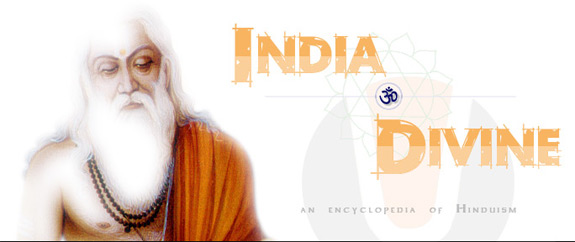

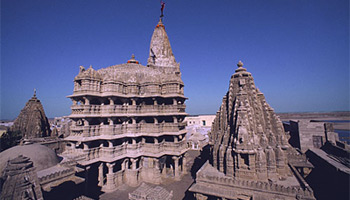


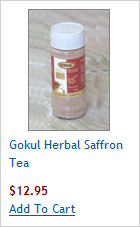
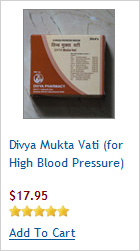

No hay comentarios:
Publicar un comentario